A wetsuit provides essential thermal insulation, protecting you from cold water while maintaining flexibility. Its thickness and type depend on water temperature, ensuring comfort and safety during activities like surfing, diving, or swimming. Understanding the relationship between wetsuit thickness and water temperature is crucial for optimal performance and protection in various aquatic conditions.
1.1 Importance of Wetsuit Thickness in Different Water Conditions
Wetsuit thickness is critical for maintaining body heat and comfort in varying water temperatures. Thicker wetsuits (e.g., 6/5 mm or 7 mm) are essential for cold water, providing maximum insulation, while thinner suits (e.g., 2 mm) are suitable for warm conditions, offering flexibility. The right thickness ensures a balance between warmth and mobility, preventing hypothermia in cold waters and avoiding overheating in warmer conditions. Proper fit and thickness are vital for performance and safety in water sports.
1.2 Brief Overview of Wetsuit Types and Their Uses
Wetsuits come in various styles, each designed for specific water conditions and activities. Full wetsuits offer maximum coverage and warmth, ideal for cold waters, while shorty wetsuits are perfect for warmer conditions, providing flexibility. Springsuits are lightweight and suitable for temperate waters, offering core protection. Additionally, accessories like booties, gloves, and hoods enhance thermal protection in extreme cold. Choosing the right wetsuit type ensures optimal comfort, flexibility, and performance for activities like surfing, diving, or swimming in diverse environments.
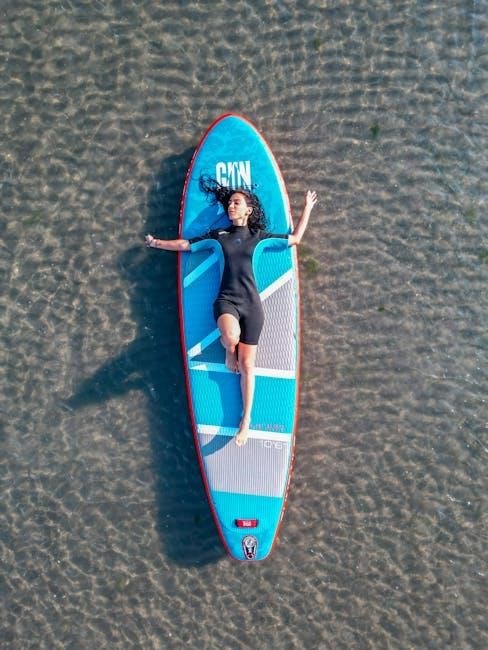
Understanding Water Temperature Categories
Water temperatures are categorized into four main groups: cold (below 50°F/10°C), cool (50°F-65°F/10°C-18°C), temperate (65°F-75°F/18°C-24°C), and warm (above 75°F/24°C). Each category requires specific wetsuit thickness for optimal comfort and protection.
2.1 Cold Water (Below 50°F or 10°C)
Cold water conditions demand thicker wetsuits to maintain body heat. Below 50°F (10°C), a 6/5 mm or 7 mm wetsuit is essential, offering maximum insulation. These suits are designed with high-quality neoprene to trap warmth efficiently. Accessories like booties, gloves, and hoods are crucial to prevent heat loss. Prolonged exposure in such temperatures without proper gear can lead to hypothermia, making the right wetsuit thickness vital for safety and comfort in icy waters.
2.2 Cool Water (50°F ⏤ 65°F or 10°C ⏤ 18°C)
Cool water conditions, ranging from 50°F to 65°F (10°C to 18°C), require a balance between insulation and flexibility. A 4/3 mm wetsuit is ideal for these temperatures, offering warmth without restricting movement. The neoprene thickness ensures core warmth while maintaining dexterity for activities like surfing or diving. Proper fit and high-quality neoprene are crucial to prevent heat loss and ensure comfort during extended time in the water. This range is chilly but not freezing, making the right wetsuit essential for optimal performance.
2.3 Temperate Water (65°F ‒ 75°F or 18°C ⏤ 24°C)
Temperate water, ranging from 65°F to 75°F (18°C to 24°C), is ideal for activities requiring both warmth and flexibility. A 3/2 mm wetsuit is recommended, providing adequate insulation while maintaining ease of movement. This thickness ensures comfort during extended sessions in the water, such as surfing or swimming, without feeling overly restrictive. It strikes a perfect balance for water temperatures that are cool enough to require protection but not cold enough for thicker suits.
2.4 Warm Water (Above 75°F or 24°C)
Warm water above 75°F (24°C) requires minimal thermal protection, allowing for maximum flexibility and comfort. A 2 mm or thinner wetsuit is ideal, offering light insulation while preventing sunburn and abrasions. Shorty wetsuits are also popular, providing coverage for the core and upper legs without restricting movement. This range is perfect for activities like snorkeling, swimming, or surfing in tropical conditions, ensuring you stay cool and comfortable in warmer climates.
Factors Influencing Water Temperature
Geographical location, seasonal changes, depth, and currents significantly impact water temperature. These factors create variations in thermal conditions, affecting wetsuit choice for different aquatic environments and activities.
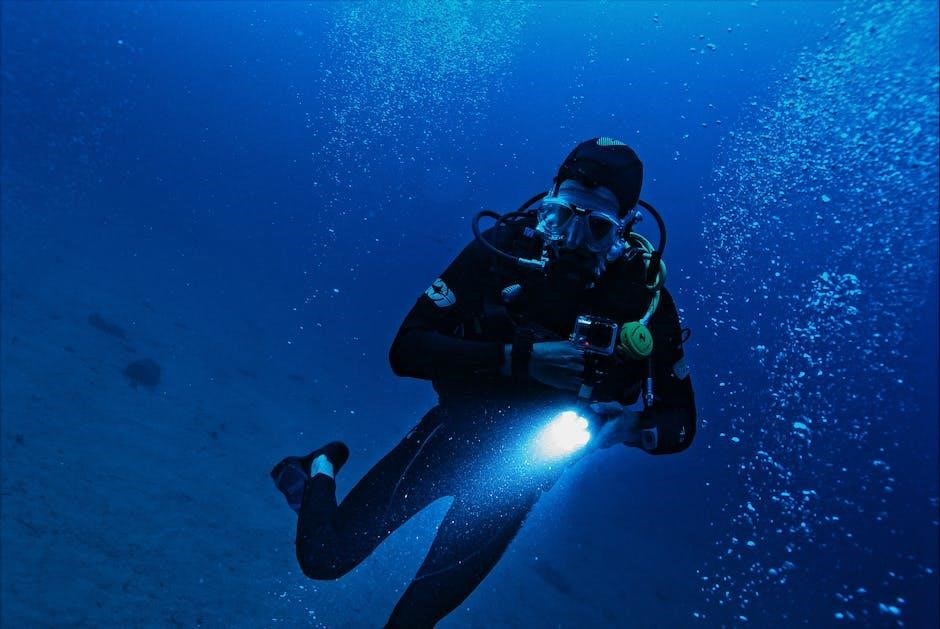
3.1 Geographical Location and Seasonal Variations
Geographical location and seasonal changes significantly influence water temperature. Tropical regions typically have warmer waters, while polar areas are colder. Seasonal variations, such as summer heat or winter cold, alter thermal conditions. For example, the Caribbean remains warm year-round, while the North Sea experiences dramatic temperature shifts. Understanding these geographical and seasonal patterns helps determine the appropriate wetsuit thickness for comfort and protection in varying aquatic environments.
3.2 Depth and Currents: How They Affect Temperature
Water depth and currents significantly impact temperature variations. Deeper waters are generally colder due to limited sunlight penetration, while surface waters warm with solar exposure. Ocean currents, such as the Gulf Stream, transport heat across regions, influencing local temperatures. These factors affect wetsuit choice, as divers and surfers in deeper or current-prone areas may need thicker suits for added warmth, despite surface conditions appearing warmer.
Wetsuit Thickness Guide Based on Water Temperature
Wetsuit thickness varies with water temperature: colder waters require thicker suits (6/5 mm or 7 mm), while warmer waters use thinner options (2 mm or less) for flexibility.
4.1 Cold Water: 6/5 mm or 7 mm Wetsuits
In cold water (below 50°F or 10°C), a 6/5 mm or 7 mm wetsuit is essential for thermal insulation. These thicker suits provide maximum warmth, reducing heat loss and preventing cold stress. The neoprene thickness ensures better protection against frigid conditions, while flexible panels maintain mobility. Accessories like booties, gloves, and hoods enhance warmth. This thickness is ideal for prolonged exposure in icy waters, balancing protection and mobility for activities like surfing or diving in extreme cold.
4.2 Cool Water: 4/3 mm Wetsuits
For cool water (50°F ‒ 65°F or 10°C ‒ 18°C), a 4/3 mm wetsuit is ideal, offering a balance of warmth and flexibility. This thickness provides sufficient insulation without hindering movement, making it suitable for spring and fall conditions. The neoprene traps warm water next to the skin, while the 3 mm torso and 4 mm legs ensure core warmth. It’s a versatile choice for water sports, keeping you comfortable in moderately cool temperatures while maintaining performance and mobility.
4.3 Temperate Water: 3/2 mm Wetsuits
In temperate waters (65°F ‒ 75°F or 18°C ⏤ 24°C), a 3/2 mm wetsuit is perfect, offering a balance of warmth and flexibility. The 3 mm torso provides core insulation, while the 2 mm legs allow for ease of movement, ideal for activities like surfing or swimming. This thickness traps a thin layer of water next to the skin, retaining body heat without restricting mobility, making it a popular choice for moderate water conditions where flexibility is key. It ensures comfort and performance in temperate climates.
4.4 Warm Water: 2 mm or Thinner Wetsuits
For warm water temperatures (above 75°F or 24°C), a 2 mm or thinner wetsuit is ideal. These suits provide minimal insulation while offering protection from the sun, wind, and abrasions. Shorty wetsuits or those with short sleeves are popular choices, allowing maximum flexibility and preventing overheating. They are perfect for tropical conditions, where the primary focus is comfort and UV protection rather than warmth. This thickness ensures a balance between light coverage and freedom of movement in warm climates.
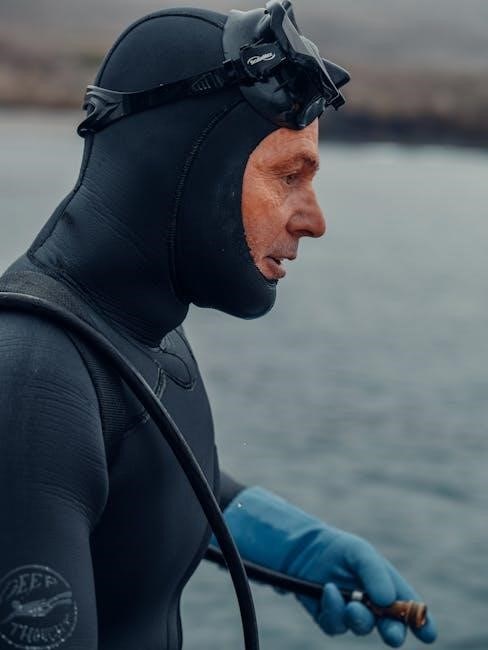
Types of Wetsuits for Different Water Conditions
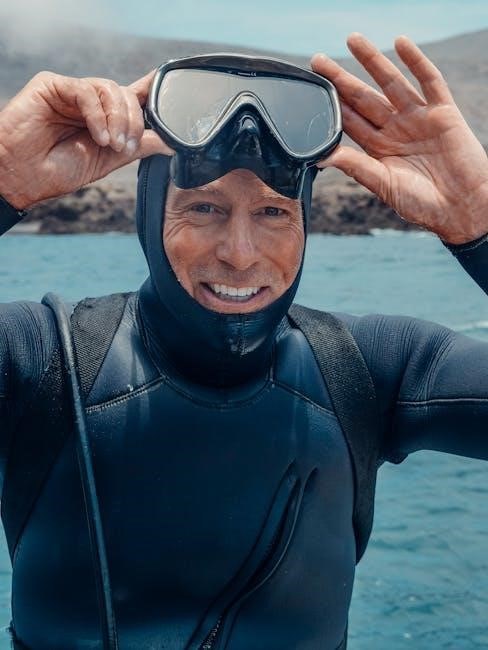
Wetsuits vary in style and thickness to suit diverse water temperatures and activities. Full suits offer maximum warmth in cold water, while shorties and springsuits are ideal for warmer conditions, providing flexibility and UV protection. Each type is designed to balance thermal insulation with mobility, ensuring comfort and performance across different aquatic environments and sports.
5.1 Full Wetsuits for Cold Water
A full wetsuit is essential for cold water conditions, providing comprehensive coverage and thermal insulation. Typically ranging from 4/3 mm to 6/5 mm in thickness, these suits are designed to retain body heat in temperatures below 50°F (10°C). Made from high-quality neoprene, they cover the torso, arms, and legs, offering protection against cold stress. Full wetsuits are a must for activities in harsh, chilly environments, ensuring comfort and safety in freezing water. Accessories like booties, gloves, and hoods enhance their effectiveness.
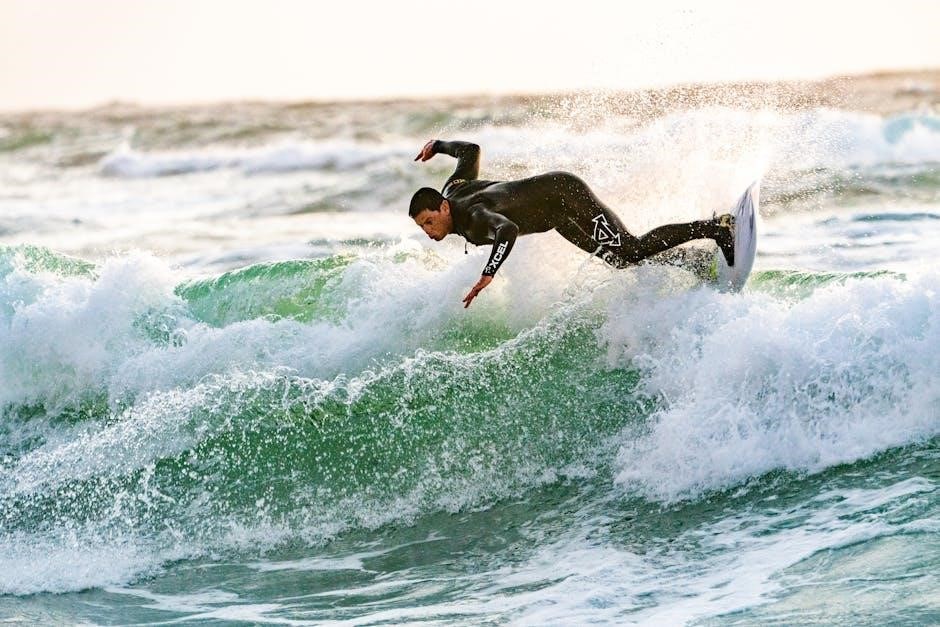
5.2 Shorty Wetsuits for Warm Water
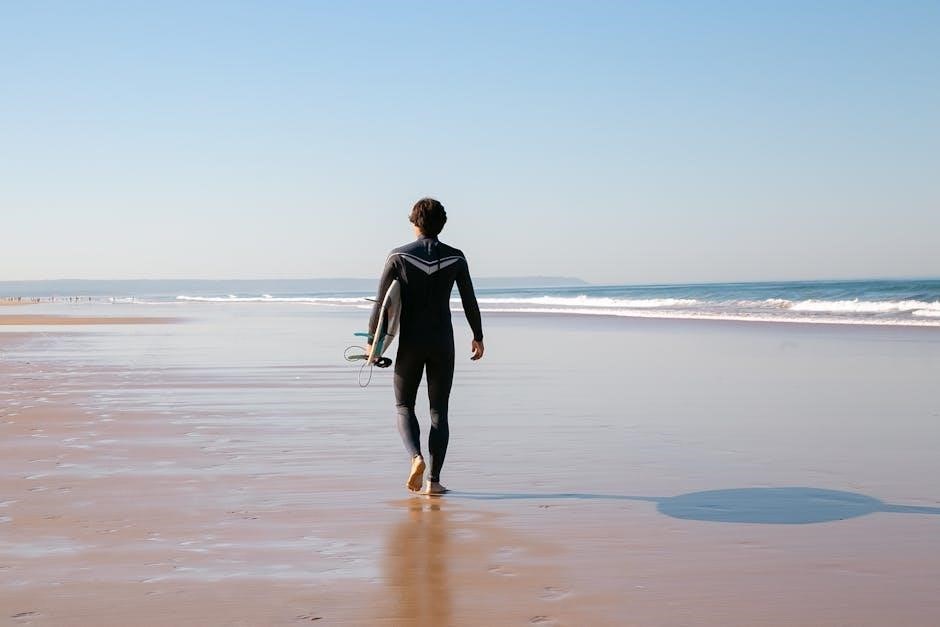
Shorty wetsuits are ideal for warm water temperatures, offering minimal coverage and maximum flexibility. With thicknesses ranging from 2 mm to 3 mm, they provide protection without excessive heat retention. Perfect for activities in tropical or summer conditions, shorties cover the torso and upper thighs, offering UV protection and abrasion resistance while allowing freedom of movement. They are a popular choice for water sports in temperatures above 75°F (24°C), ensuring comfort and practicality in balmy environments.
5.3 Springsuits for Temperate Waters
Springsuits are lightweight, short-sleeved wetsuits designed for temperate waters, typically between 65°F and 75°F (18°C to 24°C). They offer minimal coverage but provide essential protection from sun, wind, and cold. With a thickness of 2-3 mm, springsuits are ideal for activities requiring flexibility and warmth without bulk. Perfect for swimming, snorkeling, or water sports in milder conditions, they balance comfort and protection, making them a versatile choice for transitional weather or cooler summer days in temperate regions.

Accessories for Enhanced Thermal Protection
Accessories like booties, gloves, and hoods provide additional warmth in cold water, preventing heat loss and ensuring comfort during extended water activities. They enhance overall thermal protection.
6.1 Booties for Cold Water Protection
Booties are essential for cold water protection, preventing heat loss through the feet. They are typically 5mm thick, offering insulation and traction on slippery surfaces. In icy conditions, they are crucial for comfort and safety, especially during water sports. Properly fitted booties ensure warmth and flexibility, making them a vital accessory for maintaining thermal protection in cold water environments.
6.2 Gloves for Maintaining Hand Warmth
Gloves are vital for maintaining hand warmth in cold water, ensuring dexterity and grip during activities. Typically 3-5mm thick, they balance insulation with flexibility. Choose gloves with a snug fit and grip palms for better control. In extremely cold conditions, consider 5mm thickness for maximum warmth. Properly fitting gloves prevent cold water infiltration, keeping hands functional and comfortable in chilly environments, enhancing overall performance in water sports.
6.3 Hoods for Head and Neck Protection
Hoods provide crucial protection for the head and neck, preventing heat loss in cold water. Typically made from 3-5mm neoprene, they are designed to fit snugly, reducing cold water entry. Some hoods feature fleece-lined interiors for added warmth. For extreme cold, 5mm or thicker hoods are recommended. They are essential for maintaining body heat, ensuring comfort and safety in freezing conditions, and are often integrated into full wetsuits for comprehensive thermal protection.

Specialized Wetsuits for Specific Activities
Specialized wetsuits are tailored for specific water sports, such as surfing, triathlon, or diving, offering activity-specific features like flexibility, buoyancy, and durability to meet unique demands.
7.1 Surfing Wetsuits
Surfing wetsuits are designed for flexibility and durability, often featuring seam construction that allows for maximum mobility. They typically range in thickness from 3/2 mm to 6/5 mm, depending on water temperature. Thicker suits are used in colder waters to maintain warmth, while thinner options provide more freedom in warmer conditions. These wetsuits also include features like reinforced knees for added protection during intense sessions.
7.2 Triathlon Wetsuits
Triathlon wetsuits are engineered for speed and buoyancy, typically used in cooler to temperate waters. They are designed to enhance swimming efficiency, with varying thickness levels to suit different conditions. Thinner panels in the shoulders and arms improve flexibility, while thicker sections provide insulation. These wetsuits are generally thinner than surfing suits, with restrictions on maximum thickness to ensure fair competition. They are a critical piece of gear for triathletes aiming to optimize performance in open-water events.
7.3 Diving and Snorkeling Wetsuits
Diving and snorkeling wetsuits are designed to provide thermal insulation and protection from marine elements. They typically range in thickness from 3/2 mm to 7 mm, depending on water temperature. Thinner suits (2-3 mm) are ideal for warm, tropical waters, while thicker suits (5 mm or more) are better for cold conditions. These wetsuits often feature hooded designs, reinforced knees, and adjustable cuffs for a secure fit. Accessories like booties and gloves enhance warmth and protection during dives or snorkeling sessions.

Maintenance and Care for Wetsuits
Regular maintenance ensures wetsuit longevity. Rinse with fresh water, avoid direct sunlight, and use mild detergents. Store on a wide hanger to prevent stretching and damage.
8.1 Cleaning and Storing Wetsuits
Proper cleaning and storage extend a wetsuit’s lifespan. Rinse with fresh water after use, removing salt and debris. Use mild detergents or specialized cleaners to avoid damaging neoprene. Avoid direct sunlight and heat, as they can degrade the material. Store on a wide hanger to maintain shape and prevent stretching. Regular maintenance ensures flexibility and thermal performance, keeping your wetsuit in optimal condition for future use in various water temperatures.
8.2 Repairing and Replacing Wetsuits
Regular inspections can help identify tears or damage early. Small punctures can be repaired with neoprene repair kits. For larger damage, professional services may be needed. Replace your wetsuit if repairs are frequent or extensive. Neoprene loses flexibility over time, especially in warmer waters, affecting performance. Replacing every 2-5 years, depending on usage, ensures optimal protection and comfort. Proper care extends lifespan, maintaining insulation and flexibility for various water conditions.
Selecting the right wetsuit based on water temperature is essential for comfort, safety, and performance in aquatic activities. Understanding the relationship between thickness, type, and temperature ensures optimal protection. Factors like geographical location, depth, and seasonal changes also influence water temperature, guiding wetsuit choices. Proper maintenance and timely repairs extend the lifespan of your wetsuit. By following this guide, you can make informed decisions, enhancing your experience in various water conditions and activities, from surfing to diving.
